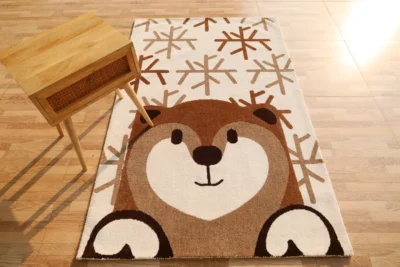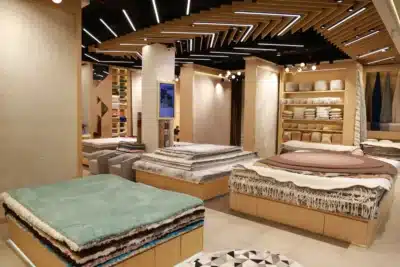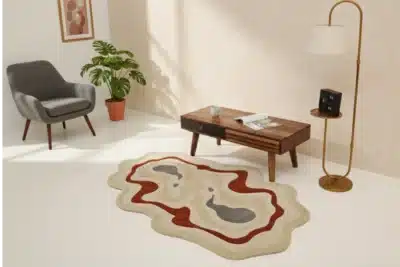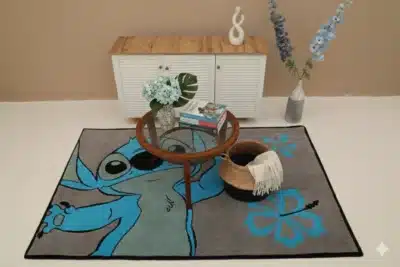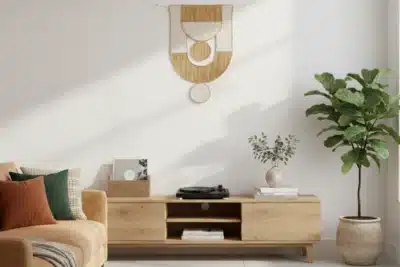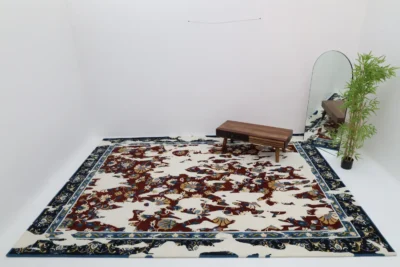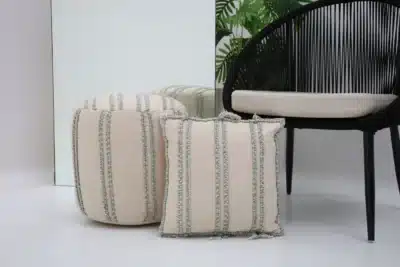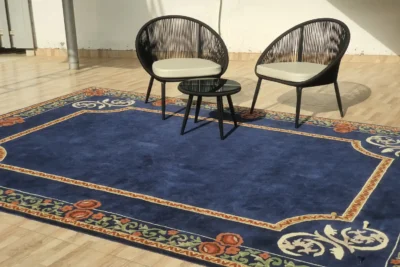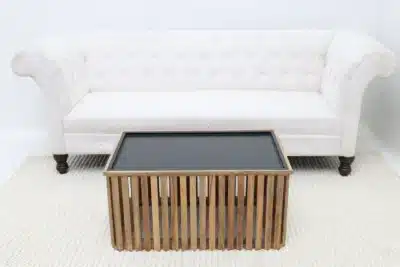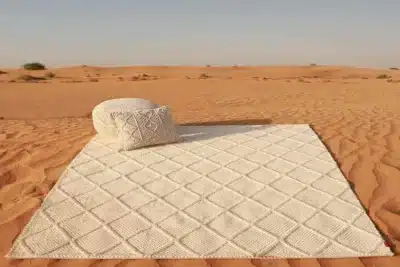Blog
اختيار حجم السجادة المناسب لا يقل أهمية عن اختيار التصميم أو اللون المناسب. فالسجادة ذات الحجم المثالي تجعل غرفتك تبدو متوازنة وواسعة ومتكاملة.
هذا الدليل من منزل رامشا يساعدك هذا التطبيق على اختيار حجم السجادة أو الموكيت المناسب لكل غرفة. استكشف تحويلات المقاسات القياسية بالأقدام والبوصات والسنتيمترات، وتعلم كيفية قياس مساحتك قبل الشراء.
تحويل حجم السجادة والسجاد القياسي
فيما يلي أحجام السجاد والبسط الأكثر شيوعًا مع تحويلاتها بالقدم والبوصات والسنتيمترات:
| الحجم (قدم) | الحجم (بوصة) | الحجم (سنتيمتر) | مثالية ل |
|---|---|---|---|
| 3x5 | 36x60 | 91x152 | المدخل، بجانب السرير، تحت طاولة القهوة |
| 4x6 | 48x72 | 122x183 | غرفة معيشة أو رواق صغير |
| 5x8 | 60x96 | 152x244 | غرفة المعيشة، بجانب سرير الملكة |
| 6x9 | 72x108 | 183x274 | غرفة معيشة أو طعام متوسطة الحجم تتسع من 4 إلى 6 كراسي |
| 8x10 | 96x120 | 244x305 | غرفة المعيشة وغرفة الطعام لـ 6-8 كراسي |
| 9x12 | 108x144 | 274x366 | غرفة معيشة كبيرة، سرير بحجم كينج |
| 10x14 | 120x168 | 305x427 | المساحات الكبيرة أو المفتوحة |
| 12x15 | 144x180 | 366x457 | غرف كبيرة أو فاخرة |
نصيحة سريعة: عند الشك، اختر سجادة أكبر قليلًا. السجاد الأكبر حجمًا يجعل الغرفة تبدو أكثر ترابطًا واكتمالًا.
أحجام السجاد حسب الغرفة
اختيار حجم السجادة المناسب لكل غرفة يُضفي عليها مظهرًا متوازنًا ومريحًا وأنيقًا. فيما يلي توصيات مفصلة لحجم السجادة لكل غرفة في منزلك.
غرفة الجلوس
عادةً ما تكون غرفة المعيشة أكبر مساحة وأكثرها وضوحًا في المنزل، لذا يلعب حجم السجادة دورًا كبيرًا في مظهرها. فالسجادة ذات الحجم المناسب تربط الأريكة والكراسي وطاولة القهوة معًا، مما يخلق مساحة واحدة متصلة.
- سجادة مقاس 5×8 قدم تناسب بشكل جيد تحت طاولة قهوة صغيرة أو بين كرسيين في الغرف المدمجة.
- سجادة مقاس 6×9 قدم تناسب الغرف المتوسطة التي تحتوي على أريكة تتسع من 2 إلى 3 مقاعد.
- السجادة التي يبلغ حجمها 8×10 أقدام هي الخيار الأكثر شيوعًا لأنها تسمح للأرجل الأمامية للأرائك والكراسي بالاستقرار على السجادة، مما يخلق مظهرًا موحدًا.
- السجادة التي يبلغ حجمها 9×12 قدمًا هي الأفضل لغرف المعيشة الكبيرة أو الأقسام على شكل حرف L.
اترك دائمًا مسافة تتراوح بين 18 و24 بوصة من الأرضية الفارغة بين حواف السجادة والجدران. هذا يُضفي توازنًا على غرفتك ويجعلها تبدو أكثر اتساعًا. إذا كانت أرضيتك خشبية، اترك بضع بوصات من الأرضية تظهر حول السجادة لتأطير المساحة بشكل طبيعي.
غرفة الطعام
في غرفة الطعام، يجب أن تغطي السجادة الطاولة والكراسي، حتى عند سحبها. هذا يمنع الحواف غير المتساوية، ويضفي على المكان مظهرًا أنيقًا ومرتبًا.
- السجاد الذي يبلغ حجمه 6×9 قدم مثالي لمجموعات الطعام الأصغر التي تتسع من 4 إلى 6 أشخاص.
- السجاد مقاس 8×10 قدم يعمل بشكل مثالي مع الطاولات المتوسطة التي تحتوي على 6 إلى 8 كراسي.
- السجاد الذي يبلغ حجمه 9×12 قدمًا مثالي للطاولات المستطيلة أو البيضاوية الأكبر حجمًا مع 8 إلى 10 كراسي.
لاختيار مقاس السجادة المناسب، قس طاولة طعامك وأضف حوالي ٢٤ بوصة من جميع الجوانب. هذا يسمح لكل كرسي بالبقاء على السجادة بالكامل، حتى عند سحبه. يجب أن تكون السجادات الموجودة أسفل طاولات الطعام سهلة التنظيف ومقاومة للبقع، لأن الانسكابات شائعة في هذه المنطقة.
غرفة نوم
تحتاج غرف النوم إلى سجاد يُضفي الراحة والدفء. يعتمد حجم السجادة المناسب على نوع سريرك، سواءً كان سريرًا فرديًا أو سريرًا كبيرًا أو سريرًا كبيرًا، وعلى المساحة الأرضية التي ترغب بها.
- السجاد الذي يبلغ حجمه 3×5 قدم هو الخيار الأمثل لوضعه على جانبي السرير.
- تعتبر السجادات التي يبلغ حجمها 5×8 قدم خيارًا رائعًا أسفل سرير بحجم كوين.
- تناسب السجادات التي يبلغ حجمها 8×10 أقدام بشكل جيد أسفل سرير بحجم كوين أو كينج، حيث تترك حوالي 2 قدم من السجادة على كل جانب.
- تبدو السجادات التي يبلغ حجمها 9×12 قدمًا أفضل مع الأسرة ذات الحجم الكبير وتغطي كلا الجانبين، بالإضافة إلى منطقة القدمين.
لوضع سجادتك بشكل صحيح، ضعها في منتصف السرير، بحيث تبدأ من منتصف لوح الرأس تقريبًا. هذا الترتيب يُضفي على الغرفة شعورًا بالنعومة والراحة. يمكنك أيضًا وضع سجاد أو مفارش صغيرة بجانب السرير إذا كنت لا تفضل وضع سجادة كبيرة تحته.
مطبخ
المطبخ منطقة حيوية، لذا يجب أن تكون السجادات فيه عملية وأنيقة. يجب أن تكون مقاومة للانسكابات والبقع وحركة الأقدام.
- سجادة مقاس 3×5 قدم تناسب تمامًا أمام الحوض أو الموقد أو جزيرة المطبخ.
- تعتبر الممرات التي يتراوح طولها بين 7 أقدام و10 أقدام هي الأفضل للمطابخ الطويلة والضيقة أو التصميمات التي تشبه الممرات.
تساعد السجادات في المطابخ على تقليل تعب القدمين أثناء الطهي، وتُضفي لونًا أو نقوشًا مميزة على الأرضيات العادية. اختر دائمًا سجادًا منخفض الوبر أو قابلًا للغسل ليسهل تنظيفه. ضع سجادًا في منتصف الممرات أو بين الخزائن لجعل المساحة تبدو أطول وأكثر راحة.
الرواق والمدخل
الممرات والمداخل هي أكثر الأماكن ازدحامًا في أي منزل. استخدام سجادة هنا يحمي أرضياتك ويضفي جوًا من الدفء والراحة على ضيوفك.
- الممرات: اختر عرضًا يتراوح بين 2.5 إلى 3 أقدام وطولًا يتراوح بين 6 إلى 14 قدمًا اعتمادًا على حجم الممر لديك.
- السجاد مقاس 3×5 قدم: يناسب بشكل أفضل بالقرب من الأبواب أو المداخل الصغيرة.
السجادات ذات الممرات تجذب الانتباه وتجعل المساحات الضيقة تبدو أطول. اترك دائمًا بضع بوصات من الأرضية ظاهرة من كلا الطرفين لتأطير السجادة بشكل أنيق. اختر مواد متينة مثل الصوف أو الجوت أو المخاليط الصناعية لسهولة العناية بها. تساعد الوسادات المانعة للانزلاق أسفل السجادات على تثبيتها في مكانها.
مكتب أو غرفة دراسة
تستفيد المكاتب المنزلية أو مناطق الدراسة من السجاد الذي يحدد مناطق العمل ويجعل ساعات الجلوس الطويلة أكثر راحة.
- السجاد مقاس 5×8 قدم يناسب بشكل جيد تحت المكتب والكرسي.
- السجاد مقاس 6×9 قدم مثالي للمساحات الأكبر التي تتضمن منطقة جلوس صغيرة أو رف كتب.
تُضفي السجادة في مكتبك دفئًا وتُقلل من صدى الصوت، خاصةً في الغرف ذات الأرضيات الصلبة. احرص على استخدام سجادة خفيفة الوزن ليسهل تحريك كرسي مكتبك. إذا كان مكتبك في منتصف الغرفة، فضع السجادة في منتصفها لإضفاء مظهر متوازن واحترافي.
منطقة خارجية أو شرفة (إضافة اختيارية)
تساعد السجادات الخارجية في تحديد مناطق الجلوس على الشرفات أو الأفنية أو الأسطح.
- السجاد الذي يبلغ حجمه 5×8 قدم أو 6×9 قدم يناسب المساحات الخارجية الصغيرة.
- تعتبر أبعاد 8×10 قدم مثالية لمناطق الجلوس في الفناء الكبيرة.
يجب أن تُصنع السجادات الخارجية من مواد مقاومة للعوامل الجوية، مثل البولي بروبيلين أو البلاستيك المُعاد تدويره. فهي مقاومة للرطوبة والبهتان والأوساخ. إضافة سجادة خارجية تُضفي على المكان شعورًا فوريًا بأنه امتداد لمساحة معيشتك.
كيفية القياس واختيار المقاس المناسب؟
قياس طول وعرض غرفتك
ابدأ بقياس الطول والعرض الإجماليين لغرفتك باستخدام شريط قياس. دوّن هذه الأبعاد على ورقة. سيساعدك هذا على فهم مساحة الأرضية المطلوبة.
عند القياس، ضع في اعتبارك كامل المساحة القابلة للاستخدام، وليس فقط المساحة المفتوحة. حدّد أماكن وضع الأثاث، مثل الأرائك والأسرة والطاولات. إذا كانت الغرفة تحتوي على زوايا أو فتحات أبواب غير اعتيادية، فقم بقياسها أيضًا. معرفة حجم الغرفة بدقة تُمكّنك من تحديد أبعاد السجادة بدقة.
تخطيط تخطيط الأثاث
حدد كيفية وضع أثاثك قبل اختيار السجادة. يؤثر وضع الأثاث على حجم السجادة والمساحة التي يجب أن تبقى ظاهرة منها.
في غرف المعيشة، يُمكنك إما وضع جميع أرجل الأثاث على السجادة لإضفاء مظهر مُترابط، أو وضع الأرجل الأمامية فقط لمساحة أكثر انفتاحًا. في غرف النوم، يُضفي وضع السجادة في منتصف السرير شعورًا بالتوازن والراحة. في غرف الطعام، يجب أن تكون السجادة واسعة بما يكفي لوضع الطاولة والكراسي عليها حتى عند سحبها.
إن تصور تصميمك قبل الشراء يضمن أن السجادة تدعم ترتيب أثاثك بدلاً من تعطيله.
اترك مساحة حول الحواف
يساعد ترك مساحة مرئية حول السجادة على جعل الغرفة تبدو أكبر وأكثر تنظيماً.
غالبًا ما ينصح مصممو الديكور الداخلي بالحفاظ على مساحة تتراوح بين 18 و24 بوصة من الأرضية الفارغة حول جميع جوانب السجادة. تعمل هذه المساحة المفتوحة كإطار بصري، وتُحدد المساحة دون أن تبدو الغرفة مزدحمة.
في المساحات الصغيرة، يمكنك تقليص هذه الحافة إلى حوالي ثماني إلى اثنتي عشرة بوصة. يكمن السر في الحفاظ على التناسب بحيث تبدو السجادة في المنتصف ويتوازن أثاثك داخل الغرفة.
قم بتحديد منطقة السجادة باستخدام الشريط اللاصق
قبل الشراء، يُنصح باختبار شكل السجادة في مساحتك. استخدم شريطًا لاصقًا أو شريطًا لاصقًا للدهان لتحديد شكل السجادة على أرضيتك.
بعد أن تستقر الخطوط العريضة، تراجع قليلًا وتأكد من أنها تتناسب مع أثاثك ومساحة المشي. تأكد من إمكانية فتح الأبواب بحرية وأن السجادة لا تعيق الممرات.
يساعدك هذا الاختبار البصري البسيط على تأكيد الحجم الصحيح ويجنبك شراء سجادة تشعر بأنها صغيرة جدًا أو كبيرة جدًا بمجرد وصولها.
خذ بعين الاعتبار شكل الغرفة
يؤثر شكل السجادة على مظهر الغرفة. السجادة المستطيلة مثالية لمعظم غرف المعيشة، وغرف الطعام، وغرف النوم.
السجادة المربعة تناسب الغرف المتساوية تقريبًا في الطول والعرض. أما السجاد الدائري، فهو مناسب للمساحات الضيقة أو لتخفيف حدة زوايا الغرف المستطيلة.
عند اختيار الشكل، احرص دائمًا على مواءمته مع تصميم أثاثك. على سبيل المثال، تبدو السجادة المستديرة جميلةً أسفل طاولة طعام دائرية، بينما تُضفي السجادة المستطيلة لمسةً طبيعيةً على الأرائك الطويلة أو الطاولات المستطيلة.
اختر السجادة حسب وظيفة الغرفة
كل غرفة لها غرض مختلف، ويجب أن تتناسب السجادة الخاصة بك مع كيفية استخدام الغرفة.
في الأماكن المزدحمة كالممرات والمطابخ، استخدم سجادًا خفيف الوبر أو منسوجًا بشكل مسطح لسهولة تنظيفه وصيانته. أما في غرف النوم أو غرف المعيشة، فاختر سجادًا أكثر سمكًا ونعومة مصنوعًا من الصوف أو القطن لمزيد من الراحة.
فكّر أيضًا في مَن سيستخدم المساحة. فالمنازل التي تضم أطفالًا أو حيوانات أليفة تستفيد من مواد قابلة للغسل ومقاومة للبقع، بينما تبدو المساحات الرسمية أفضل مع التصاميم الفخمة أو المزخرفة.
التركيز على التوازن والتناسب
ينبغي أن تُكمّل السجادة الغرفة دائمًا، لا أن تُطغى عليها. يجب أن يُخلق حجمها وشكلها وموضعها توازنًا بين السجادة والأثاث والأرضيات المرئية.
إذا كانت السجادة صغيرة جدًا، فقد تجعل الأثاث يبدو متناثرًا. وإذا كانت كبيرة جدًا، فقد تخفي جمال أرضياتك وتجعل الغرفة تبدو أصغر. التناسب الصحيح للسجادة يجعل كل شيء يبدو مدروسًا ومرتبًا بشكل جيد.
إعادة التحقق قبل الشراء
قبل إتمام عملية الشراء، راجع جميع قياساتك مرة أخرى. تأكد جيدًا من تصميم الأثاث، وخلوص الباب، وحركة المرور. قارن أبعادك بأحجام السجاد القياسية المتوفرة، مثل خمسة أقدام في ثمانية أقدام، أو ستة أقدام في تسعة أقدام، أو ثمانية أقدام في عشرة أقدام، أو تسعة أقدام في اثني عشر قدمًا.
إذا لم يناسب أيٌّ من المقاسات القياسية تصميمك تمامًا، ففكّر في طلب سجادة مُصمّمة خصيصًا لك بأبعادك الدقيقة. تتيح لك العديد من ماركات السجاد اختيار المقاس واللون والخامة للحصول على مُلاءمة دقيقة.
🛒 اشتري أنواع مختلفة من السجاد من رامشا هوم:

Article By
Asif Hasan
Asif Hasan is a recognized expert in textile artistry, global sourcing, and e-commerce growth within the hand-knotted rugs and carpets sector. As the CEO of منزل رامشا, he focuses on preserving traditional weaving techniques while implementing modern digital strategies to bring authentic, high-quality floor coverings from artisan workshops to global customers. He specializes in optimizing the carpet supply chain and ensuring the sustainable trade of premium home textiles.

 0
0



